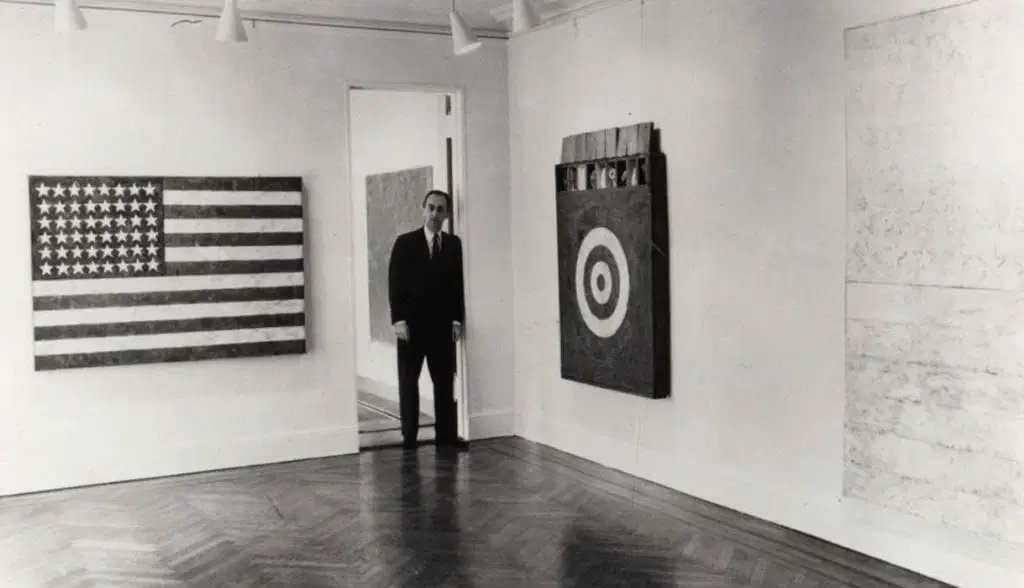
Jasper Johns’ first solo exhibition, held at the Leo Castelli Gallery in New York City in January 1958, was a pivotal moment not only in his career but also in the history of American art. This show marked the emergence of Johns as a key figure in the transition from Abstract Expressionism to what would become known as Pop Art and Minimalism. The exhibition showcased a collection of works that included some of his most iconic pieces, such as Flag (1954-55), Target with Plaster Casts (1955), and Green Target (1955). These works introduced a new visual language that challenged the dominant art movements of the time and earned Johns both acclaim and criticism from the art world.
At the heart of the exhibition were Johns’ encaustic paintings, a technique involving the application of hot wax mixed with pigment, which gave his works a textured, tactile quality. The most prominent works featured in the show were those that depicted everyday objects and symbols—flags, targets, numbers—rendered in a style that was both familiar and unsettling. Johns’ Flag paintings, in particular, became the centerpiece of the show. These paintings took the American flag, a powerful symbol loaded with cultural and political meanings, and turned it into an object of art. The ambiguity of the Flag—was it a painting of a flag, or was it a flag itself?—challenged the viewer’s perception and invited a deeper consideration of the nature of art and representation.
Another standout piece was Target with Plaster Casts, which featured a painted target beneath a row of plaster casts of parts of the human body, such as a foot, a hand, and a penis, housed in small wooden compartments above the target. This work exemplified Johns’ ability to combine imagery and materials in a way that was both direct and enigmatic. The target, a simple geometric design, was rendered in bright, flat colors, while the plaster casts introduced a stark contrast in texture and subject matter. The juxtaposition of the two elements highlighted the tension between the abstract and the representational, a theme that ran throughout Johns’ work.
The critical reception of Johns’ first solo exhibition was mixed but predominantly positive, with many critics recognizing the significance of his work, even if they were not entirely sure how to categorize it. The art critic Leo Steinberg, in particular, was one of Johns’ early champions. In a review for Art News, Steinberg praised Johns for his “radical redefinition of the subject matter of art,” noting that Johns had introduced “things the mind already knows” into the realm of fine art, thereby challenging the abstract, emotional focus of Abstract Expressionism.
Steinberg observed that Johns’ use of familiar symbols like flags and targets allowed for a new kind of viewer engagement. Instead of being absorbed by the artist’s emotions, as was the case with Abstract Expressionist works, viewers of Johns’ paintings were invited to engage with the artwork intellectually. Steinberg argued that Johns’ work presented a “return to the object” in a way that had not been seen before, blending elements of Dada and Surrealism with a distinctly modern sensibility.
Clement Greenberg, one of the most influential critics of the time and a staunch supporter of Abstract Expressionism, had a more ambivalent response to Johns’ work. While Greenberg acknowledged Johns’ technical skill and the precision of his encaustic technique, he was less enthusiastic about the conceptual aspects of the work. In his view, the overt symbolism in Johns’ paintings was too literal and lacked the emotional depth and spontaneity that he valued in Abstract Expressionism. Despite his reservations, Greenberg recognized that Johns was tapping into something new and significant in the art world.
In contrast, critic Harold Rosenberg, another leading voice in the art world, viewed Johns’ work more favorably. Rosenberg, who had coined the term “Action Painting” to describe the dynamic, gestural style of artists like Jackson Pollock, saw in Johns’ work a different kind of “action.” He described Johns’ paintings as “events” rather than static objects, noting that the tension between the recognizable imagery and the painterly surface created a dynamic interaction between the viewer and the work. Rosenberg appreciated the way Johns’ paintings played with the boundary between art and life, challenging conventional notions of what a painting could be.
Johns’ work also resonated with a younger generation of critics and artists who were beginning to question the dominance of Abstract Expressionism. The Pop artists, in particular, saw in Johns a kindred spirit who was exploring the intersection of popular culture and fine art. Andy Warhol, Roy Lichtenstein, and Robert Rauschenberg were among those who were influenced by Johns’ approach to imagery and his use of everyday objects as subject matter. Rauschenberg, in particular, was close to Johns both personally and professionally, and the two artists often shared ideas and techniques. The success of Johns’ first solo show helped pave the way for the emergence of Pop Art as a major movement in the 1960s.